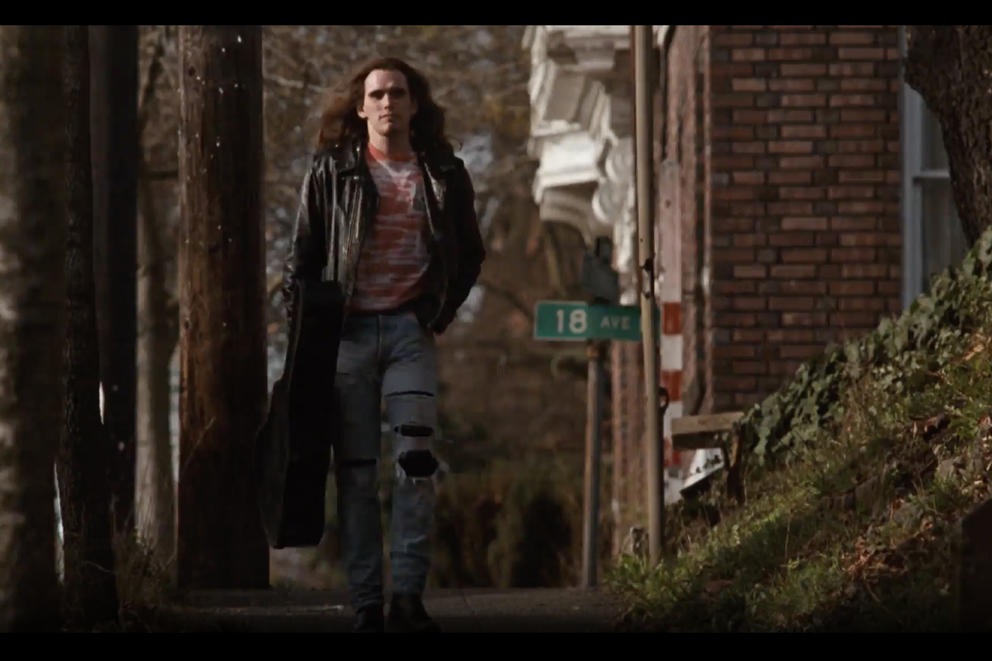The very first Hollywood film shot in Seattle was Tugboat Annie by MGM in the 1930s, which gives us a feel for the Depression-era waterfront and its plucky maritime culture. Cinderella Liberty, a 1973 film about a sailor on leave, records the last days of the port-town era along First Avenue.
The “dreary works of man” turned out to have some Hollywood appeal. In movie after movie, from the ’60s through the ’80s, Hollywood used Seattle as a backdrop for crime and car chases.
Take the Space Needle, featured in the 1963 Elvis Presley film It Happened at the World’s Fair. Fine dining and Belgian waffles were given screen time — but then leap to 1974’s The Parallax View, a thriller whose opening scenes, a political assassination, are set on the Needle. The hit man in the film must be one of the dumbest in history because he runs to the Needle’s roof to escape! He falls off, of course. If the Needle was supposed to symbolize a shiny new future, a decade after it was built it had already acquired some ominous Watergate-era tarnish.
One drama offered some hope. Seattle was known for a high suicide rate, but also efforts to offer mental health support. In 1965’s The Slender Thread, Sidney Poitier is a UW student volunteer at the then-new Crisis Clinic. He tries to save the life of a woman, played by Anne Bancroft, who has overdosed on sleeping pills—to a jazzy score by Seattle’s Quincy Jones. She lives in a mid-century modern house overlooking Shilshole, and her husband is a commercial fisherman who is, oddly, often wearing a Mad Men-style suit and tie. Still, the picture presented a mental health drama about mid-century alienation as the city galvanized to help a woman in trouble.
In the ’70s, as the region struggled through the Boeing recession, Seattle became a kind of second-rate San Francisco, with filmed chase scenes and Dirty Harry knockoffs. Who can forget the muscle-car chase through town by John Wayne in McQ? Even more impressive was Connie Stevens as a campy ’70s crimefighter. Her romp through town in a dune buggy in the 1976 movie Scorchy is epic. The chase even ends with a shooting atop Ivar’s, then Stevens leaps off the ferry ramp at Colman Dock!
Seattle also seemed to be a magnet for cinematic con artists. 1973’s Harry in Your Pocket was shot in part in Union Station, Pioneer Square, and Downtown and features a team of pickpockets. Another con movie is David Mamet’s 1987 House of Games, in which a Seattle psychiatrist, played by Lindsay Crouse, decides to study con men — a key meeting place is the now-gone 211 Billiard Club on Union. The shrink is conned herself, but there’s a deadly twist.
And speaking of deadly, the campy thriller Black Widow, also from ’87, features Debra Winger as a federal investigator chasing down a female serial killer, played by Theresa Russell, who offs her husbands for money.
This ushered in what writer Tim Egan has dubbed Northwest Noir. If Seattle could be a place of crime, then so too its beautiful surroundings could be infused with a sense of menace. Director David Lynch’s TV series Twin Peaks captured the dark presence of Northwest forests and mountains and starred UW trained actor Kyle MacLachlan. Lynch’s 1992 movie prequel, Twin Peaks: Fire Walk with Me, had some Seattle scenes, but they were overshadowed by the appearances of demons, visions, dream figures in a surrealistic hash — and a memorably eerie musical score.
In the ’90s, noir seems to have given way to love, whimsy and grunge. Harry and the Hendersons was a warm-hearted take on the biggest Northwest mystery, Bigfoot, turning the ominous Lynch landscape of Twin Peaks into a safe zone for a lovable Sasquatch. Sleepless in Seattle saw a Seattle man, played by Tom Hanks, learning about love from, of all people, Rob Reiner at The Athenian restaurant in Pike Place Market. The most magical thing in this movie isn’t Hanks finding love with Meg Ryan, but Hanks living in a Lake Union houseboat far beyond his means.
The most definitive Seattle movie of the era, perhaps ever, is 1992’s Singles — a kind of Friends-meets-grunge film about young adults in the early ’90s living cheap in Seattle. Matt Dillon’s band, Citizen Dick, is played by Pearl Jammers. Singles is jammed with every Seattle cliché: coffee, mosh pits, flannel — and one lead character is even a high-speed transit advocate! Any dark side the city or the grunge scene might have had is steamrollered by the vibe of 20-something love.
In 1999 the teen flick 10 Things I Hate About You was ostensibly set in Seattle, though the school used was Tacoma’s magnificent Stadium High. Teen angst and the quest for freedom ring loudly for many non-boomers in these movies. Seattle was no longer a dumpy port town or crime center, but a setting for coming-of-age fantasies. “Seattle nice” outlasted noir, apparently.
Nowadays Seattle has been largely bypassed by Hollywood. Tinseltown has found a town that makes a better Seattle: Vancouver, B.C., is now a regular stand-in for the Emerald City.
That’s Hollywood.
For more on this story, listen to the Mossback podcast:






